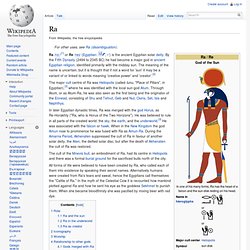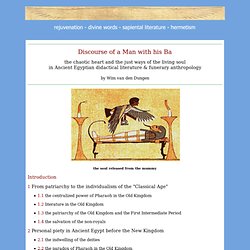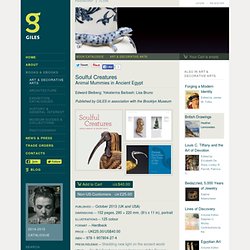

Ra. Ra /rɑː/[1] or Re /reɪ/ (Egyptian: 𓂋ꜥ, rˤ) is the ancient Egyptian solar deity.

By the Fifth Dynasty (2494 to 2345 BC) he had become a major god in ancient Egyptian religion, identified primarily with the midday sun. The meaning of the name is uncertain, but it is thought that if not a word for 'sun' it may be a variant of or linked to words meaning 'creative power' and 'creator'.[2] In later Egyptian dynastic times, Ra was merged with the god Horus, as Re-Horakhty ("Ra, who is Horus of the Two Horizons"). He was believed to rule in all parts of the created world: the sky, the earth, and the underworld.[3] He was associated with the falcon or hawk.
When in the New Kingdom the god Amun rose to prominence he was fused with Ra as Amun-Ra. All forms of life were believed to have been created by Ra, who called each of them into existence by speaking their secret names. Role[edit] Ra and the sun[edit] Egyptian God-Thoth. Ancient Egyptian concept of the soul. Ib (heart)[edit] To ancient Egyptians, the heart was the seat of emotion, thought, will and intention.

This is evidenced by the many expressions in the Egyptian language which incorporate the word ib, Awt-ib: happiness (literally, wideness of heart), Xak-ib: estranged (literally, truncated of heart). This word was transcribed by Wallis Budge as Ab. In Egyptian religion, the heart was the key to the afterlife. It was conceived as surviving death in the nether world, where it gave evidence for, or against, its possessor.
Sheut (shadow)[edit] A person's shadow or silhouette, Sheut (šwt in Egyptian), is always present. The shadow was also representative to Egyptians of a figure of death, or servant of Anubis, and was depicted graphically as a small human figure painted completely black. Ren (name)[edit] Ba[edit] Ba takes the form of a bird with a human head. The 'Ba' (bꜣ) was everything that makes an individual unique, similar to the notion of 'personality'. Ka[edit] Akh[edit] Akh glyph Notes[edit] ANCIENT EGYPT : The Discourse of a Man with his Ba.
Introduction This famous work is preserved in a single manuscript from the XIIth Dynasty.

In 1843, the egyptologist Lepsius puchased this nameless hieratic papyrus and brought it to Berlin were it became "Berlin Papyrus 3024". In 1859, he published the text without translation. The first transcription & translation was by Adolf Erman in 1896, under the title : Das Gespräch eines Lebensmüden mit seiner Seele. The Egyptian text can also (partly) be found in Sethe's Aegyptische Lesestücke (1928). Faulkner published his translation as : "The Man who was tired of Life" (in JEA, n°42, 1956, pp.21 - 40). According to Assmann in his Maat (1999), this highly remarkable work belongs to what he calls "discourses on Maat" or "sapiental literature", consisting of teachings & complaints.
Parts of the Soul. Soulful Creatures, Animal Mummies in Ancient Egypt. Published by GILES in association with the Brooklyn Museum Add to Cart US$40.00 Non-US CustomersUK£25.00 Sales Points "This beautifully illustrated book...sheds new light on the uniquely Ancient Egyptian practice of animal mummification" Sarah Griffiths, Ancient Egypt Magazine "Soulful Creatures is especially to be commended for its beautiful illustrations"—Kmt: The Modern Journal of Ancient Egypt "The book provides an excellent overview of animal cults in ancient Egypt presented in a language suitable for the general public as well as being appropriate for scholars"—Salima Ikram, Bryn Mawr Classical Review Accompanies a major travelling exhibition - Bowers Museum, Santa Ana, CA, March 22-June 15, 2014; Memphis Brooks Museum of Art, Memphis, TN, October 25, 2014-January 18, 2015; Brooklyn Museum , NY, Summer/Fall 2015 About the Book In the ancient burial grounds of Saqqara, outside Memphis, over five million individual ibis mummies have been excavated from one cemetery alone.

ANCIENT EGYPT / Studies in Ancient Egyptian Religion & Philosophy.